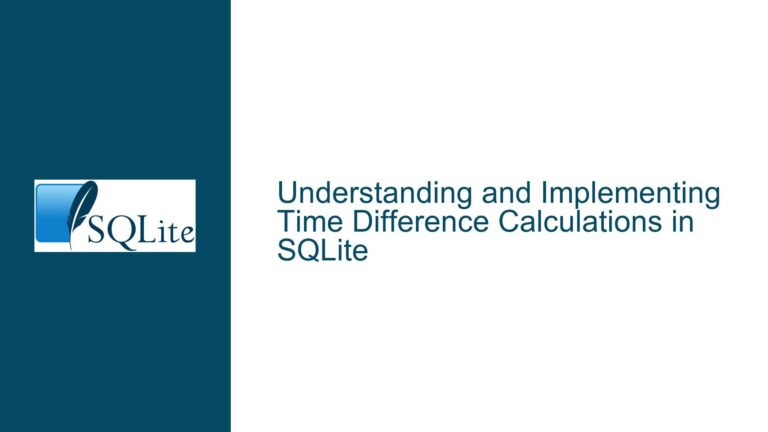Retrieving First and Last Complete Weeks Without Subquery in SQLite
Understanding the Challenge of Aggregating Week Boundaries with Full Data Coverage
The core challenge presented revolves around efficiently determining the earliest and latest weeks within the dayViews table that contain exactly seven days of view data. The current approach uses a subquery to first identify weeks with a complete set of seven days and then calculates the minimum and maximum week numbers from this filtered subset. The user seeks to eliminate the subquery while maintaining accuracy and performance.
Structural Dependencies Between Aggregation Layers
The existing query operates in two distinct phases:
- Inner Aggregation Phase: Groups records by week number (adjusted via
strftime('%W', dayDate, '+1 day')) and filters out weeks that do not have exactly seven days of data usingCOUNT(dayViews) = 7. - Outer Calculation Phase: Computes the minimum and maximum week numbers from the filtered list of complete weeks.
This two-phase process is inherently tied to the order of operations in SQL. Aggregate functions like MIN() and MAX() cannot directly reference the results of a COUNT() filtered by HAVING in the same query level because HAVING conditions are applied after grouping but before final result set projection. Thus, the subquery acts as an intermediate step to isolate the filtered groups before applying the outermost aggregation.
Key dependencies include:
- Grouping Logic: Weeks are defined using
strftime('%W', dayDate, '+1 day'), which shifts the week calculation by one day to align with specific week-start conventions (e.g., weeks starting on Monday). - Data Completeness Check: The
COUNT(dayViews)ensures only weeks with seven distinct days are considered, preventing partial weeks from skewing results. - Index Utilization: The primary key on
dayDateprovides fast access to date values, but function-based grouping (strftime) may bypass index optimizations.
Limitations of Single-Level Aggregation in SQLite
SQLite’s query execution model processes WHERE, GROUP BY, and HAVING clauses in a strict sequence. A single query level cannot simultaneously filter groups based on aggregate values (e.g., COUNT(dayViews) = 7) and compute extremal values (MIN(), MAX()) over those filtered groups. Attempting to merge these operations into one query level would either:
- Fail Syntax Checks: Referencing aggregate results like
COUNT()directly in aWHEREclause is invalid, asWHEREcannot access column aliases defined in theSELECTlist. - Produce Incorrect Results: Moving the
HAVINGcondition to the outer query would apply it after calculatingMIN()andMAX(), which aggregates all weeks indiscriminately.
Thus, the subquery is not merely a stylistic choice but a structural necessity given SQLite’s operational semantics. Any alternative approach must replicate this two-phase logic without violating the language’s constraints.
Performance Implications of Subqueries vs. Alternative Constructs
A common misconception is that subqueries inherently degrade performance. In reality, SQLite’s query optimizer often flattens subqueries into joins or scans when possible, rendering their performance impact negligible. The true bottlenecks arise from:
- Full-Table Scans: If no index exists on
dayDate, grouping by a computed week number requires scanning all rows. - Function-Based Grouping: Applying
strftimetodayDateprevents the use of indexes for range scans or direct lookups, forcing temporary storage of computed values. - Intermediate Result Sets: Large datasets may require materializing the inner query’s results in temporary storage, increasing memory or disk usage.
Therefore, the efficiency of the current query depends more on schema design and function usage than the presence of a subquery. Optimizations should target these areas rather than attempting to remove the subquery itself.
Root Causes of Subquery Necessity and Performance Constraints
Cause 1: Inability to Filter Aggregates Before Outer Aggregation
The fundamental limitation driving the need for a subquery is SQL’s requirement that aggregate filtering (HAVING) occur after grouping but before projection of final results. To compute extremal values (MIN(), MAX()) over a subset of groups defined by their aggregate properties (e.g., COUNT(dayViews) = 7), two separate processing stages are unavoidable. The outer query cannot reference the filtered groups directly because those groups are not materialized until the inner query completes execution.
Cause 2: Function-Based Grouping Bypassing Index Optimizations
The use of strftime('%W', dayDate, '+1 day') to derive week numbers forces SQLite to compute this value for every row during query execution. Since the primary key index on dayDate stores raw date strings, not precomputed week numbers, the database cannot leverage the index to accelerate grouping. This results in a full scan of the dayViews table to compute week numbers and group rows, which becomes costly for large datasets.
Cause 3: Schema Design Limitations
The dayViews table schema does not include precomputed week numbers or auxiliary columns that could simplify grouping. While normalizing date-related values (e.g., storing ISO week numbers directly) would reduce runtime computation, it requires schema changes that may not be feasible in all environments. Without such optimizations, the query must recompute week numbers on every execution.
Optimizing Week Boundary Calculations Without Sacrificing Correctness
Step 1: Validate the Necessity of the Subquery
Before attempting optimizations, confirm that the subquery cannot be eliminated without altering the query’s semantics. Testing alternatives like combining HAVING with window functions or using FILTER clauses reveals their limitations:
Window Functions:
SELECT DISTINCT MIN(strftime('%W', dayDate, '+1 day')) OVER () AS min_week, MAX(strftime('%W', dayDate, '+1 day')) OVER () AS max_week FROM dayViews GROUP BY strftime('%W', dayDate, '+1 day') HAVING COUNT(dayViews) = 7;This approach fails because the
HAVINGclause filters out groups before the window functions process them, leaving no rows to computeMIN()andMAX()over.FILTER Clause:
SQLite does not support theFILTERclause for aggregate functions, unlike PostgreSQL. Thus, conditional aggregation cannot be used here.
These experiments reinforce that the subquery is unavoidable for correct results under current SQLite constraints.
Step 2: Accelerate Function-Based Grouping with Indexed Computed Columns
To mitigate the performance penalty of computing week numbers at runtime, create a virtual or stored computed column that materializes the week number for each date:
-- SQLite 3.31+ required for generated columns
ALTER TABLE dayViews ADD COLUMN week_no TEXT
GENERATED ALWAYS AS (strftime('%W', dayDate, '+1 day')) VIRTUAL;
Creating an index on this column enables index-assisted grouping:
CREATE INDEX idx_dayViews_week_no ON dayViews(week_no);
Rewriting the original query to use week_no simplifies grouping and leverages the index:
SELECT MIN(week_no), MAX(week_no)
FROM (
SELECT week_no, COUNT(dayViews) AS days
FROM dayViews
GROUP BY week_no
HAVING days = 7
);
While this retains the subquery, it reduces computational overhead by avoiding repeated strftime calls and enabling index-driven grouping.
Step 3: Evaluate Materialized Views for Precomputed Aggregates
For read-heavy workloads, precompute weekly aggregates using a materialized view or auxiliary table:
CREATE TABLE weekly_aggregates (
week_no TEXT PRIMARY KEY,
days INTEGER NOT NULL
);
INSERT INTO weekly_aggregates
SELECT strftime('%W', dayDate, '+1 day'), COUNT(dayViews)
FROM dayViews
GROUP BY 1;
Refreshing this table periodically (e.g., via triggers) allows the original query to bypass the subquery entirely:
SELECT MIN(week_no), MAX(week_no)
FROM weekly_aggregates
WHERE days = 7;
This approach shifts computational costs to write operations, trading off real-time data freshness for faster reads.
Step 4: Leverage Partial Indexes for Filtered Aggregation
SQLite’s partial indexes can optimize the inner query’s HAVING days = 7 condition by indexing only weeks with seven days:
CREATE INDEX idx_week_7_days ON dayViews(strftime('%W', dayDate, '+1 day'))
WHERE (
SELECT COUNT(*)
FROM dayViews AS d2
WHERE strftime('%W', d2.dayDate, '+1 day') = strftime('%W', dayViews.dayDate, '+1 day')
) = 7;
However, this method is not directly supported due to SQLite’s restrictions on correlated subqueries in index definitions. Instead, maintain a separate table or use triggers to track complete weeks, enabling direct index access.
Step 5: Benchmark and Compare Execution Plans
Use SQLite’s EXPLAIN QUERY PLAN directive to analyze the original and optimized queries:
EXPLAIN QUERY PLAN
SELECT MIN(WeekNo), MAX(WeekNo) FROM (
SELECT strftime('%W', dayDate, '+1 day') AS WeekNo, COUNT(dayViews) AS Days
FROM dayViews
GROUP BY WeekNo
) WHERE Days = 7;
Key indicators of efficiency include:
- SCAN TABLE dayViews: Suggests a full table scan, which is slow for large datasets.
- USE TEMP B-TREE FOR GROUP BY: Indicates in-memory sorting/grouping, which can be optimized with indexes.
After adding the week_no generated column and index, the plan should show SEARCH TABLE dayViews USING INDEX idx_dayViews_week_no, confirming index-assisted grouping.
Final Recommendation: Embrace the Subquery with Schema Optimizations
Given SQLite’s operational constraints, the most effective strategy combines schema modifications with the original subquery structure:
- Add a Generated Column for precomputed week numbers.
- Index the Generated Column to accelerate grouping.
- Retain the Subquery to correctly filter and aggregate results.
This approach respects SQLite’s processing model while minimizing runtime computation through schema-level optimizations. Alternative methods like materialized views offer further gains for specific use cases but require balancing freshness against performance.






